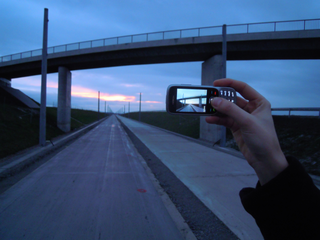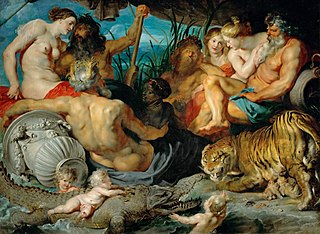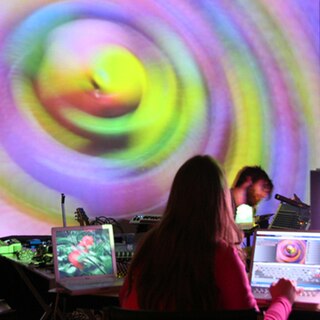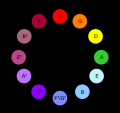
Aesthetics, or esthetics, is a branch of philosophy that deals with the nature of beauty and taste, as well as the philosophy of art. It examines aesthetic values, often expressed through judgments of taste.
Musique concrète is a type of music composition that utilizes recorded sounds as raw material. Sounds are often modified through the application of audio signal processing and tape music techniques, and may be assembled into a form of montage. It can feature sounds derived from recordings of musical instruments, the human voice, and the natural environment as well as those created using synthesizers and computer-based digital signal processing. Compositions in this idiom are not restricted to the normal musical rules of melody, harmony, rhythm, metre, and so on. The technique exploits acousmatic sound, such that sound identities can often be intentionally obscured or appear unconnected to their source cause.

An image is an artifact, such as a photograph or other two-dimensional picture, that resembles a subject—usually a physical object—and thus provides a depiction of it. In the context of signal processing, an image is a distributed amplitude of color(s). A pictorial script is a writing system that employs images as symbols for various semantic entities, rather than the abstract signs used by alphabets.
Noise music is a genre of music that is characterised by the expressive use of noise within a musical context. This type of music tends to challenge the distinction that is made in conventional musical practices between musical and non-musical sound. Noise music includes a wide range of musical styles and sound-based creative practices that feature noise as a primary aspect.

Installation art is an artistic genre of three-dimensional works that are often site-specific and designed to transform the perception of a space. Generally, the term is applied to interior spaces, whereas exterior interventions are often called public art, land art or art intervention; however, the boundaries between these terms overlap.

Aesthetics of music is a branch of philosophy that deals with the nature of art, beauty and taste in music, and with the creation or appreciation of beauty in music. In the pre-modern tradition, the aesthetics of music or musical aesthetics explored the mathematical and cosmological dimensions of rhythmic and harmonic organization. In the eighteenth century, focus shifted to the experience of hearing music, and thus to questions about its beauty and human enjoyment of music. The origin of this philosophic shift is sometimes attributed to Baumgarten in the 18th century, followed by Kant.
Sound art is an artistic activity in which sound is utilized as a primary medium or material. Like many genres of contemporary art, sound art may be interdisciplinary in nature, or be used in hybrid forms. According to Brandon LaBelle, sound art as a practice "harnesses, describes, analyzes, performs, and interrogates the condition of sound and the process by which it operates."

A work of art, artwork, art piece, piece of art or art object is an artistic creation of aesthetic value. Except for "work of art", which may be used of any work regarded as art in its widest sense, including works from literature and music, these terms apply principally to tangible, physical forms of visual art:
Visual music, sometimes called colour music, refers to the creation of a visual analogue to musical form by adapting musical structures for visual composition, which can also include silent films or silent Lumia work. It also refers to methods or devices which can translate sounds or music into a related visual presentation. An expanded definition may include the translation of music to painting; this was the original definition of the term, as coined by Roger Fry in 1912 to describe the work of Wassily Kandinsky. There are a variety of definitions of visual music, particularly as the field continues to expand. In some recent writing, usually in the fine art world, visual music is often confused with or defined as synaesthesia, though historically this has never been a definition of visual music. Visual music has also been defined as a form of intermedia.

VJing is a broad designation for realtime visual performance. Characteristics of VJing are the creation or manipulation of imagery in realtime through technological mediation and for an audience, in synchronization to music. VJing often takes place at events such as concerts, nightclubs, music festivals and sometimes in combination with other performative arts. This results in a live multimedia performance that can include music, actors and dancers. The term VJing became popular in its association with MTV's Video Jockey but its origins date back to the New York club scene of the 70s. In both situations VJing is the manipulation or selection of visuals, the same way DJing is a selection and manipulation of audio.
Applied aesthetics is the application of the branch of philosophy of aesthetics to cultural constructs. In a variety of fields, artifacts are created that have both practical functionality and aesthetic affectation. In some cases, aesthetics is primary, and in others, functionality is primary. At best, the two needs are synergistic, in which "beauty" makes an artifact work better, or in which more functional artifacts are appreciated as aesthetically pleasing. This achievement of form and function, of art and science, of beauty and usefulness, is the primary goal of design, in all of its domains.
Dick Raaijmakers, also known as Dick Raaymakers or Kid Baltan, was a Dutch composer, theater maker and theorist. He is considered a pioneer in the field of electronic music and tape music, but has also produced numerous musical theater pieces and theoretical publications.
D-Fuse are a London-based audiovisual artist collective, who use emerging creative technologies to explore social and environmental issues.

The arts are a very wide range of human practices of creative expression, storytelling and cultural participation. They encompass multiple diverse and plural modes of thinking, doing and being, in an extremely broad range of media. Both highly dynamic and a characteristically constant feature of human life, they have developed into innovative, stylized and sometimes intricate forms. This is often achieved through sustained and deliberate study, training and/or theorizing within a particular tradition, across generations and even between civilizations. The arts are a vehicle through which human beings cultivate distinct social, cultural and individual identities, while transmitting values, impressions, judgments, ideas, visions, spiritual meanings, patterns of life and experiences across time and space.
Amy Alexander is an artist and researcher working in audio/visual performance, interactive art and software art, under a number of pseudonyms including VJ Übergeek and Cue P. Doll. She is a Professor at the Department of Visual Arts at the University of California, San Diego.

Modern sculpture is generally considered to have begun with the work of Auguste Rodin, who is seen as the progenitor of modern sculpture. While Rodin did not set out to rebel against the past, he created a new way of building his works. He "dissolved the hard outline of contemporary Neo-Greek academicism, and thereby created a vital synthesis of opacity and transparency, volume and void". Along with a few other artists in the late 19th century who experimented with new artistic visions in sculpture like Edgar Degas and Paul Gauguin, Rodin invented a radical new approach in the creation of sculpture. Modern sculpture, along with all modern art, "arose as part of Western society's attempt to come to terms with the urban, industrial and secular society that emerged during the nineteenth century".
Glenda León is a Cuban artist born in Havana, in 1976.
Non-narrative film is an aesthetic of cinematic film that does not narrate, or relate "an event, whether real or imaginary". It is usually a form of art film or experimental film, not made for mass entertainment.

The Video Noisefields (1974) by Steina and Woody Vasulka is an important example of early formal and technical experimentation with analog video. The video runs for twelve minutes and five seconds and materially visualizes the deflected energy of the electronic signal. The video switches between two sources throughout, which creates a flickering effect. The imagery is based on the deflection of electronic signals, and a colorizer is used to add color variation. In the video, a circular form materializes on the screen and presents a division between inner and outer. A pulsation between the two is sustained throughout.
Ines Reingold-Tali, known by her stage names Inéz, Inèz or Inez, is an Estonian new media artist, musician, composer and writer on sound art, noise, electronic music, glitch and digital culture. She lives and works in Finland. Since the mid-1990s she has belonged to a new generation of composers in Finland interested in experimental interdisciplinary art projects and electronic music. Her repertoire includes electroacoustic chamber music, experimental, electronic and film music. She has been engaged in commissioned projects in the fields of electroacoustic, contemporary chamber music and experimental music, in different audiovisual art projects, video art, poetry, performance, theater, short films and radio-art. Her compositions have been broadcast internationally on various radio stations and television channels in many European countries, Australia, Canada and the USA. Her works have been published on solo-albums and international compilations by various labels, incl. K-tel International, FG Music/Naxos, YOCOMA, YAP and Charm of Sound. She has been nominated to participate in various international festivals, exhibitions and conferences, Florence Biennale 2007 in Italy, LACDA International Juried Competition Winners Show (award) at the Los Angeles Center for Digital Art in USA 2007, 30e Festival International des Musiques Syntheses 2000 in France and international conferences on musicology, among others.









